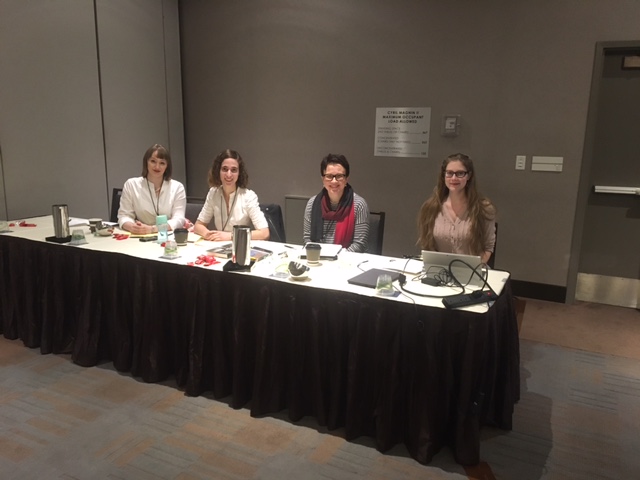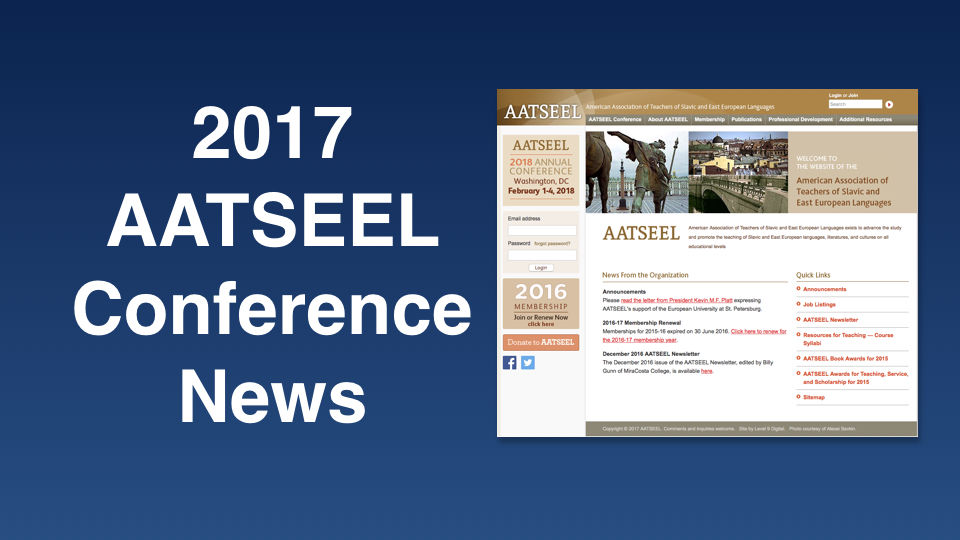Here I am with former UIowa students at the AATSEEL (American Association of Teachers of Slavic and East European Languages) National Meeting, San Francisco, CA, February 2-5, 2017! Greta (Indiana University), Hilah (Washington University in St. Louis), and Emily (Boston College) are all working on Russian and/or Comparative Literature degrees! Very proud of my smart young ladies! Great panel!

Session 4-7 Panel – 3 Feb 2017
Panel: Interdisciplinary Conversations on The Kreutzer Sonata Variations
- Location: Cyril Magnin II
- Organizer: Anna Barker, The University of Iowa
- Chair: Anna Barker, The University of Iowa
- Conference Program Schedule [PDF]
Panelist: Anna Barker, The University of Iowa
- Title: “A Well-Lit Space That Lies Ahead”: A Meditation on Leo Tolstoy’s Kreutzer Sonata
- Author: Anna Barker, The University of Iowa
- Abstract: This presentation provides a brief history of “The Kreutzer Sonata” composition, publication, and critical reception in the context of the material presented in Michael Katz’s The Kreutzer Sonata Variations. Tolstoy’s view about art is examined within the broader framework of other works such as Confession, The a Kingdom of God is Within You, and What is Art?
Panelist: Hilah Kohen, Washington University in St. Louis
- Title: The Kreutzer Sonata’s Interwar Echoes: International Variations on Personal Themes
- Author: Hilah Kohen, Washington University in St. Louis
- Abstract: This paper draws inspiration from Michael Katz’s The Kreutzer Sonata Variations to seek new readings of The Kreutzer Sonata in the writings of Tolstoy’s younger contemporaries. Specifically, as Zinaida Gippius and Virginia Woolf searched for new expressions of gender and sexuality, they reacted directly to the sexual morality of Tolstoy’s novella. Their reactions included two short stories by Gippius whose close parallels to The Kreutzer Sonata have not been examined previously. I will analyze how those stories and Woolf’s letters to Vita Sackville-West undermine Tolstoy’s moral system not so much by contradicting its prescriptions as by undermining its assumptions about what a marriage or a sexual relationship must be. This analysis illuminates a broader cultural dialogue that connected Russia and Britain in the early twentieth century and has affected Anglophone-Russophone relationships ever since.
Panelist: Greta Biedermann, University of Iowa
- Title: Examining the “Untranslatable” through Retranslation of Tolstoy’s “The Kreutzer Sonata”
- Author: Greta Biedermann, Indiana University
- Abstract: With retranslation of literary classics on the rise, “Examining the ‘Untranslatable’ through Retranslation of Tolstoy’s “The Kreutzer Sonata”” investigates the work of five translators in order to analyze the methods used to translate the short story’s narrative style, including the element skaz, considered an “untranslatable” realia. Considering the goals of Tolstoy and his narrator, portions of the text have been chosen which markedly use skaz and are vital to the story’s narrative structure in order to examine how these goals are executed. Then the translated passages are compared, discussing how each approached the realia and how those choices affect a reader’s understanding of the text and its aims. The final purpose of the paper is to compare these translation choices with other theories of realia and skaz translation in order to determine whether the methodologies used in translation of “The Kreutzer Sonata” are consistent with common techniques or contain wisdom for future translation work.
Panelist: Emily Larson, Boston College
- Title: Playing ‘The Kreutzer Sonata’: Marriage and Wifehood in Theatrical Adaptation
- Author: Emily Larson, Boston College
- Abstract: This presentation examines English-language theatrical adaptations of Tolstoy’s Kreutzer Sonata. Particular attention is paid to three productions which reached American theatre audiences. The first is an early “adaptation” (in the loosest sense of the word) by Jacob Gordin, which was originally written in Yiddish. This script was later translated into English by American playwright Langdon Mitchell and staged on Broadway in 1906. The second is an adaptation by Nancy Harris, originally staged at the Gate Theatre in London which subsequently transferred to LaMaMa in New York City for a short run in 2012. The third is a home-grown adaptation by Utah playwright, Eric Samuelsen, which premiered at Plan-B Theatre Company in Salt Lake City in 2015. The focus of this project was to examine how playwrights and theatre-makers from different historical eras have chosen to deal with Tolstoy’s material and to endeavor to interpret how the persona of the wife has been treated in various staged adaptations through an analysis of scripts, original production archival materials and published reviews.
Learn More
Learn more about the upcoming 2018 AATSEEL conference in Washington, D.C..


